Standards Worldwide
Standards Worldwide
Phone +49 30 58885700-07

Standard [CURRENT]
ASTM B 733:2022
Standard Specification for Autocatalytic (Electroless) Nickel-Phosphorus Coatings on Metal
- German title
- Autokatalytische Nickel-Phosphor-Überzüge auf Metallen
- Publication date
- 2022
- Original language
- English
- Pages
- 17
- Publication date
- 2022
- Original language
- English
- Pages
- 17
- DOI
- https://dx.doi.org/10.1520/B0733-22
Product information on this site:
Quick delivery via download or delivery service
Buy securely with a credit card or pay upon receipt of invoice
All transactions are encrypted
Short description
1.1 This specification covers requirements for autocatalytic (electroless) nickel-phosphorus coatings applied from aqueous solutions to metallic products for engineering (functional) uses. 1.2 The coatings are alloys of nickel and phosphorus produced by autocatalytic chemical reduction with hypophosphite. Because the deposited nickel alloy is a catalyst for the reaction, the process is self-sustaining. The chemical and physical properties of the deposit vary primarily with its phosphorus content and subsequent heat treatment. The chemical makeup of the plating solution and the use of the solution can affect the porosity and corrosion resistance of the deposit. For more details, see ASTM STP 265 ( 1 ) 2 and Refs ( 2 ), ( 3 ), ( 4 ), and ( 5 ) . 1.3 The coatings are generally deposited from acidic solutions operating at elevated temperatures. 1.4 The process produces coatings of uniform thickness on irregularly shaped parts, provided the plating solution circulates freely over their surfaces. 1.5 The coatings have multifunctional properties, such as hardness, heat hardenability, abrasion, wear and corrosion resistance, magnetics, electrical conductivity provide diffusion barrier, and solderability. They are also used for the salvage of worn or mismachined parts. 1.6 The low phosphorus (2 to 4 % P) coatings are microcrystalline and possess high as-plated hardness (620 to 750 HK 100). These coatings are used in applications requiring abrasion and wear resistance. 1.7 Lower phosphorus deposits in the range between 1 % and 3 % phosphorus are also microcrystalline. These coatings are used in electronic applications providing solderability, bondability, increased electrical conductivity, and resistance to strong alkali solutions. 1.8 The medium phosphorous coatings (5 to 9 % P) are most widely used to meet the general purpose requirements of wear and corrosion resistance. 1.9 The high phosphorous (more than 10 % P) coatings have superior salt-spray and acid resistance in a wide range of applications. They are used on beryllium and titanium parts for low stress properties. Coatings with phosphorus contents greater than 11.2 % P are not considered to be ferromagnetic. 1.10 Units- The values stated in SI units are to be regarded as standard. 1.11 The following precautionary statement pertains only to the test method portion, Section 9 , of this specification. This standard does not purport to address all of the safety concerns, if any, associated with its use. It is the responsibility of the user of this standard to establish appropriate safety, health, and environmental practices and determine the applicability of regulatory limitations prior to use. 1.12 This international standard was developed in accordance with internationally recognized principles on standardization established in the Decision on Principles for the Development of International Standards, Guides and Recommendations issued by the World Trade Organization Technical Barriers to Trade (TBT) Committee.
ICS
25.220.40
DOI
https://dx.doi.org/10.1520/B0733-22
Also available in
Loading recommended items...
Loading recommended items...
Loading recommended items...
